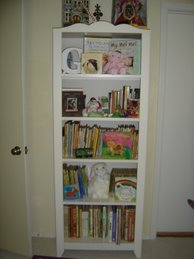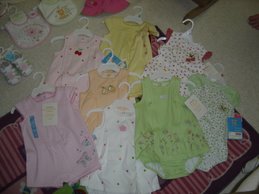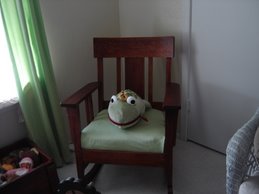Steve and I talked about attachment and how we were going to handle various situations. We have read a number of books, talked with professionals, and spoke with parents who have already adopted from China. What we have learned is that there are many resources for attachment disorders, to expect/be prepared for some issues, to pay attention to the child and let her be your guide. On that note, there are things that we want to do to help facilitate her attachment with us. This following note was posted from a person who is waiting for their second child from China. She is not a professional, but what she writes all follows what professionals suggest. Specifically, the parents must do all the caregiving for some time, i.e. diapers, feed, hold, rock, etc. That doesn't mean that we don't want our family and friends involved or be afraid to touch her. Thanks for your patience and understanding and if you have any questions, please ask! We want all of you to feel like you are part of this, too!
Explaining attachment to family members
We did a lot of educating of family members while we were waiting last time. It was a long wait back then, too, so we had plenty of time. I pointed out that family members may not understand some of the things we would need to do. That they would see us treating a one year old like an infant and this would seem wrong to them. I pointed out that they needed to understand that she may never have been treated the way an infant should be treated, and that she needed that stage with us, as her parents, so she could learn to trust us.
I told them that they would not be able to hold her for a while. Maybe two months, maybe six months - it would depend on how well we felt the attachment process was going. They were not pleased with this, and some of them needed to be pointed to web sites before they grudgingly said okay.
As it turned out, we started letting them hold her for short periods at about 6 weeks. She knew we were her parents by that point, and she wouldn't stay with them for long before she wanted to come back to us. Preparing them for two to six months made that six weeks a lot easier to get through.
We had some family members who were violently opposed to the family bed. I told them they were welcome to raise their family as they saw fit, and that their opinions were duly noted and they should not feel the need to repeat them. I was nice about it, but I got my point across. Some who were opposed to the family bed "got it" when I said "she's been in an orphanage, it's likely that the last time that she was alone was when she was abandoned.
Once arriving at the orphanage she slept in a room with twelve babies in it, there is no way we can put her in a room alone and expect her to just deal with it".This time I am reminding them of some of what we taught them last time: No one will feed the new baby except us. No one will be holding her for a while.
Here is another post that comes from the attachment website we have listed under our favorite sites. They also have lots of other good information.
Do
1. Trust the parent's instincts. Even a first time parent may notice subtle symptoms that well-meaning family and friends attribute to "normal" behavior.
2. Accept that attachment issues are difficult for anyone outside of the parents to see and understand.
3. Be supportive even if you think everything looks fine to you.
4. Allow the parents to be the center of the baby's world. One grandfather, when greeting his grandson, immediately turns him back to his mom and dad and says positive statements about his good mommy and daddy.
5. As hard as it may be for you, abide by the requests of the parents. Even if the baby looks like he really wants to be with Grandma, for example, he needs to have a strong attachment to his parents first. Something as simple as passing the baby from one person to another or allowing others, even grandparents, to hold a baby who is not "attached" can make the attachment process that much longer and harder.
6. Accept that parenting children who are at-risk for or who suffer from attachment issues goes against traditional parenting methods and beliefs. Parenting methods that work for many children can be detrimental to a child with attachment issues.
7. Remember that there is often a honeymoon period after the child arrives. Many babies do not show signs of grief, distress, or anxiety until months after they come home. If the parents are taking precautions, they are smart and should be commended and supported!
Don't
1. Assume an infant is too young to suffer from emotional issues related to attachment. Babies are not immune.
2. Underestimate a new parent's instincts that something isn't right.
3. Judge the parent's parenting abilities. What looks like spoiling or coddling may be exactly what the child needs to overcome a serious attachment disorder. Parenting methods that work for many children can be detrimental to a child with attachment issues.
4. Make excuses for the child's behaviors or try to make the parent feel better by calling certain behaviors "normal". For example, many children who suffer from attachment issues may be labeled strong-willed by well-meaning family members. While being strong-willed can be seen as a positive personality trait, this type of behavior in an attachment-impaired child may signify problems.
5. Accuse the parent of being overly sensitive or neurotic. They are in a position to see subtle symptoms as no one else can.
6. Take it personally if asked to step back so the parents can help their child heal and form a healthy and secure attachment. You may be asked not to hold the baby for more than a minute. This is not meant to hurt you. It is meant to help prove to the baby who his mommy and daddy are. Up until now the child's experience has been that mommies and daddies are replaceable. Allowing people to hold the baby before he has accepted his forever mommy and daddy can be detrimental to the attachment process.
7. Put your own timeframes on how long attachment should take. One mother was hurt when she was chastised by a relative who couldn't understand...after all, the baby had been home six months. It could take weeks, months, even years. Every child is different.
8. Offer traditional parenting advice. Some well-meaning family members will tell a new parent not to pick the baby up every time he cries because it will spoil him. A child who is at-risk or who suffers from attachment issues must be picked up every single time he cries. He needs consistent reinforcement that his mommy & daddy will always take care of him and always keep him safe.
9. Fall into the appearance trap. Some babies/toddlers with attachment issues can put on a great show to those outside of the mother/father. What you see is not always a true picture of the child. Even babies as young as 6-months-old are capable of “putting on a good face” in public.
10. Lose hope. With the right kind of parenting and therapy, a child with attachment issues can learn to trust and have healthy relationships. But it does take a lot of work and a good understanding of what these children need.
Wednesday, March 14, 2007
Subscribe to:
Post Comments (Atom)






















1 comment:
This is very interesting and almost all of it is new information for me. Thanks for sharing it!
If I ever inadvertently give you any assvice, please call me out on it!
Post a Comment